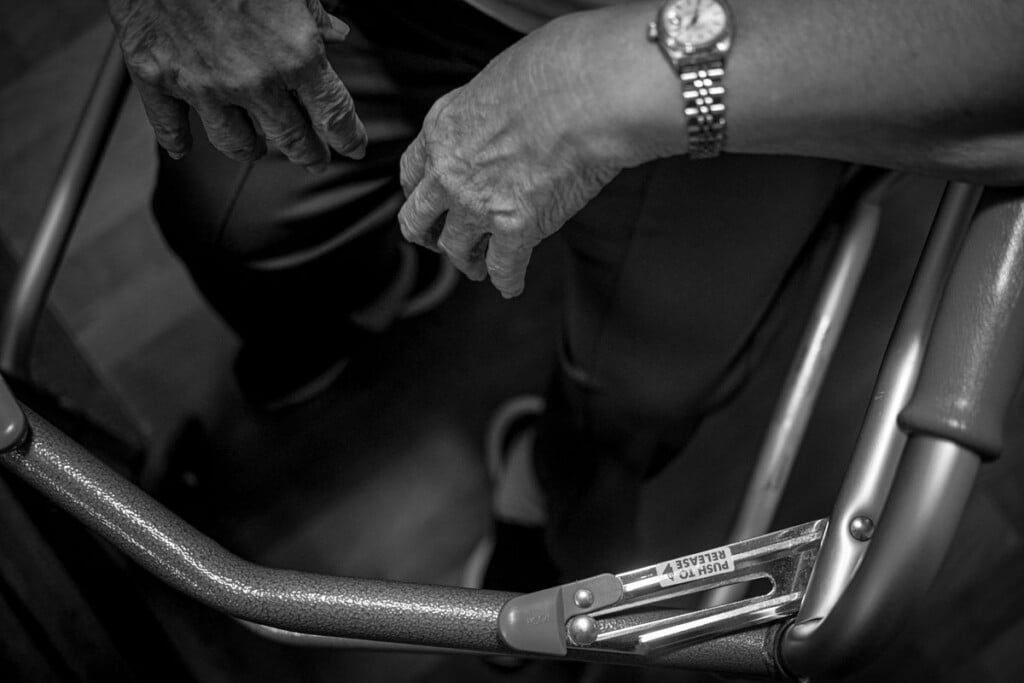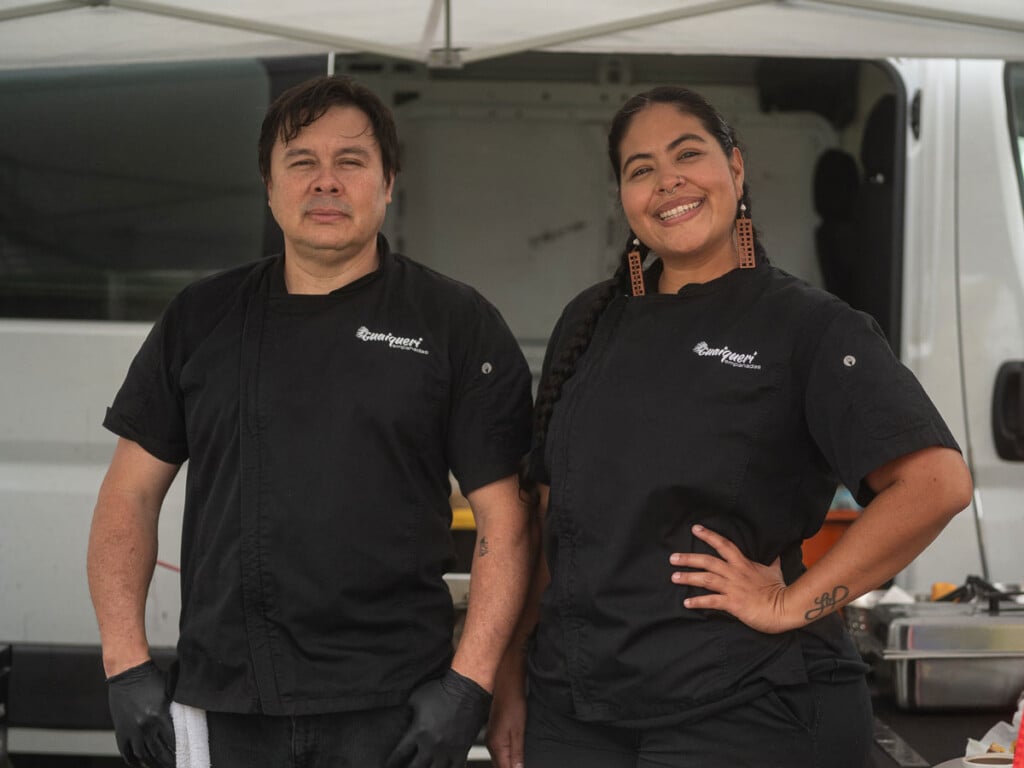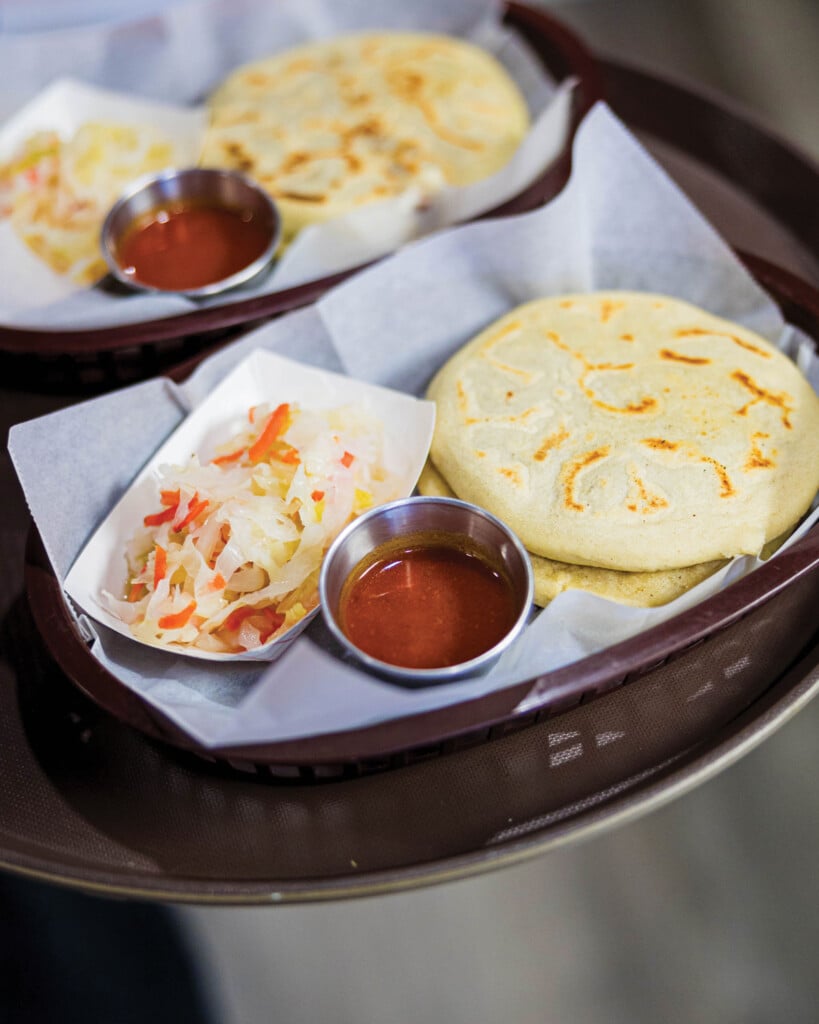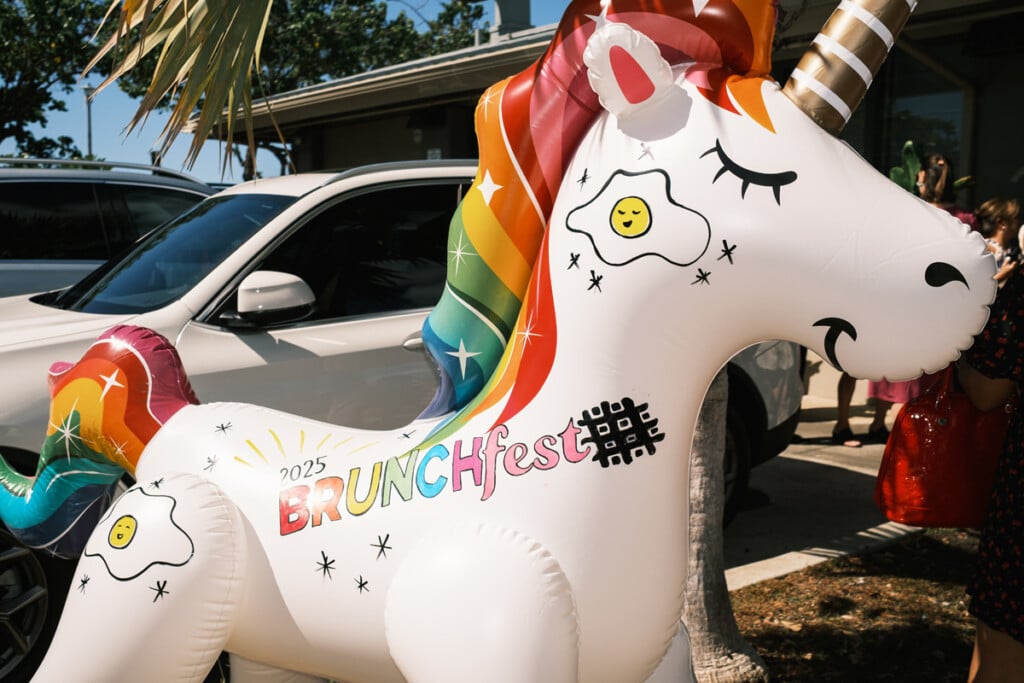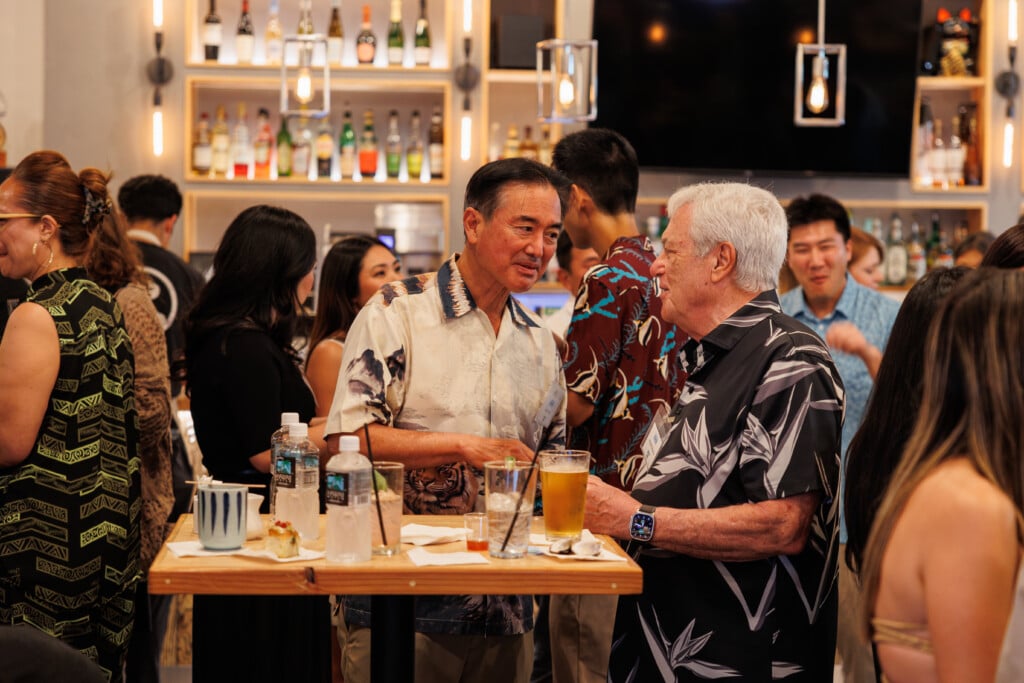What Are We Doing to Fix Hawai‘i’s Homeless Crisis?
The Aloha State now has the highest number of homeless per capita in the nation. What are we doing to help the individuals and families living on the streets?

In January, homeless service providers counted more than 400 people living in this encampment in Kaka‘ako, near the Children’s Discovery Center. Photo: Odeelo Dayondon
April Fuiava was working at the front desk of a Waikīkī Hotel, her husband was a day laborer and the two were making tough calls just about every day. With seven kids, money was always tight. After the rent was paid—$2,000 for an apartment in ‘Ālewa Heights—there wasn’t much for anything else. Buy groceries or keep the lights on. Pay the vehicle registration or fill up the cars with gas. “Some days, we wouldn’t have food,” Fuiava says. But even though things were bad, things were never that bad, and the 36-year-old never imagined she’d end up where she did—her family homeless, living in a van and an SUV parked most days along Kapālama Canal.
It’s been a year since the Fuiavas moved onto the streets. Their landlord decided to sell, and they couldn’t afford to move into a new place. They thought living in their vehicles would be temporary, just until they saved up enough for a rental deposit. But weeks stretched into months. Fuiava lost her job because she couldn’t get to work on time. Her husband’s casual work also dried up and, for a while, they were living on the proceeds of his recycling only. He finally found a full-time job, earning just above minimum wage.
SEE ALSO: Photo Essay: What Do You Do When the Homeless Man on the Street is Your Father?
“We never thought this was going to happen to us. To be living like this is inhumane,” says Fuiava, standing outside of her van on a hot Saturday afternoon. The family is at Kaka‘ako Waterfront Park, where Fuiava and her husband, Fuamete, are meeting up with a social service agency in hopes of getting help covering their vehicle registration and safety check. An illegal car on the streets is a liability the family can’t afford. While the parents wait, most of the kids have snatched up the chance to play in the park, but two of the little ones stay in the van for a nap.
The couple’s oldest is a 16-year-old boy; their youngest is 2. And there’s another one on the way. “My kids are like, when are we going to get a place?” Fuiava says. “Being homeless, it’s humbled me. I never pictured myself here.”

[Left] Seifina Selifis, 38, poses with her two children, 7-year-old Asfin and 9-month-old Jalefin. The family has been on the streets since September, struggling to save enough money for a place to rent. Seifina works the graveyard shift at a McDonald’s in Kāne‘ohe; her husband, MJ, works during the day at McKinley Car Wash and watches the kids at night. [Right] In January, a homeless encampment in Kaka‘ako was growing so large it felt like a small community. Kids rode bikes up and down the side streets; parents arrived home in the late afternoon and started to prepare dinner. Photo: Odeelo Dayondon
Hawai‘i is known for its beaches, its culture and, increasingly, its homeless crisis. Today, the state has the highest number of homeless per capita in the nation, with nearly 45 homeless for every 10,000 people, compared to 19 nationally. The situation has attracted national headlines and dominated the attention of local lawmakers.
The most visible response from local officials has been to take a hard line when it comes to the unsheltered homeless, moving them out of neighborhoods with new, specifically written laws in an approach Mayor Kirk Caldwell has dubbed “compassionate disruption.” In recent months, his administration has kicked up enforcement of a sit-lie ban for sidewalks and regularly conducted homeless sweeps to move encampments off public land. Critics of the approach say it makes it harder to help the homeless, whose ranks continue to grow.
Statewide in fiscal year 2014, nearly 14,300 Hawai‘i residents accessed homeless-shelter or outreach services, up 30 percent from 2007. Meanwhile, the number of sheltered and unsheltered homeless counted in the state’s annual “point in time” survey has grown to nearly 7,000, up by about 14 percent since 2007.
Fortunately, “disrupting” the homeless isn’t the only strategy being pursued by local government. The state and city are partnering with homeless-service providers to roll out a system to triage the homeless population, getting help to those in greatest need; they’re also launching new programs aimed at getting the homeless into permanent housing quicker, and embarking on projects to build truly affordable housing, from micro-apartments to “tiny homes” and units built out of shipping containers. Will these tactics work?
“Thinking differently”

The state’s Next Step shelter opened in 2006 as a temporary place to house homeless displaced when the city started closing Ala Moana Beach Park at night. It has no planned closure date. Photo: Odeelo Dayondon
In 2006, the state converted a Kaka‘ako Warehouse into a temporary emergency homeless shelter for some 200 people displaced when the city started closing Ala Moana Beach Park at night. The new shelter, called Next Step, was part of what would become an unprecedented expansion of the state’s homeless-services network. That expansion began in 2006 as part of a plan to end homelessness in Hawai‘i within a decade. The fact that the 200-bed Next Step not only remains open, but is at capacity, and that the state’s plan to end chronic homelessness by 2015 is rarely mentioned, speaks volumes about Hawai‘i’s current homeless crisis.

Ketsen Alafonso, 36, photographed near Kaka‘ako Waterfront Park with her 4-year-old daughter. Ketsen was living at Kūhiō Park Terrace, when she started falling behind in rent. Her job at Burger King didn’t cover all the expenses needed to take care of herself and her three children. The family got evicted in early 2014, couldn’t find a place at a homeless shelter and recently lost what little income they were getting when their welfare benefits ran out. Photo: Odeelo Dayondon
Growing the existing homeless-services network—adding more shelter beds, more outreach programs and more money—simply hasn’t worked. “Shelters serve a purpose, but the solution to homelessness is not to build more shelters. We learned that,” says Lori Tsuhako, administrator of the state’s Homeless Programs Office. “We have to start thinking differently.”
For homeless-service providers, advocates and policymakers, “thinking differently” has taken shape as a statewide effort aimed at streamlining the homeless-services pipeline—assessing individuals’ needs, getting them the right amount of support and moving them into housing more quickly. The new direction, formally adopted by the Hawai‘i Interagency Council on Homelessness, follows a national trend toward the so-called “housing first” approach, and bucks the conventional—and still pervasive—belief that homeless people placed too quickly in permanent housing (without tackling the financial, behavioral or substance-abuse issues that put them there) will fall right back out onto the streets.
But widespread changes to how homeless on the streets are helped are still years off and will require an expansion of Hawai‘i’s affordable-housing inventory. In the meantime, most homeless families and individuals continue to encounter an overwhelmed system of services whose pathways to housing have gotten longer and less defined. Shelters in the urban core have little or no space for new families. And once a family gets in, they often languish, unable—even with the shelter’s assistance—to find a rental cheap enough or a landlord who will take them.
On O‘ahu, the average stay for families in emergency shelters is 193 days, up from 113 in 2012, according to the University of Hawai‘i Center on the Family. The average stay in a transitional shelter is a year. And the safety nets for the poorest—public housing and Section 8 housing vouchers—are maxed out. With some 10,000 families on the waiting list, it can take up to a decade to get into a public-housing unit on O‘ahu.
With no other place to go, many have taken to finding safety in numbers, building encampments scattered across urban Honolulu. In Kaka‘ako alone in early January, service providers counted more than 400 homeless people in an encampment near the Children’s Discovery Center. Families and singles were living in tents and lean-tos, and new neighbors were coming in every day. On a weekday afternoon, the place felt like a community—kids were playing in the street, dogs were yapping at each other, parents were getting home and preparing to make dinner.

Keideen Helly, 3, plays with a friend in the tent she shares with her grandmother, Nina Kaneso. Photo: Odeelo Dayondon
Nina Kaneso, 59, has just bathed at Kaka‘ako Waterfront Park with her 3-year-old granddaughter, and the two are sitting on lawn chairs outside their tarpaulin dwelling letting their hair dry in the sun. Kaneso is her granddaughter’s primary caregiver, and the pair previously lived with Kaneso’s brother and his family. When her brother lost his home two years ago, everyone was out on the streets.
Now, Kaneso and her granddaughter share a cot in their makeshift tent, built with tarps and held up by pieces of wood and furniture. Other relatives live in tents nearby. Kaneso’s tiny dwelling sits on the concrete sidewalk, and one wall is partially open to the elements. When it rains, everything gets wet. But Kaneso keeps the dwelling tidy—everything has a place. She can’t get her granddaughter off the streets, at least for now, so she focuses on filling the 3-year-old’s life with routine—chores, hygiene, meal times. “I live here. I have nowhere else to go,” Kaneso says, running a comb through her hair. “It’s hard out here. Everything is hard.”
Seifina Selifis uses that word—hard—to describe her family’s life on the streets. The 38-year-old lives in a two-person tent in Kaka‘ako with her husband, MJ, and their two children, 7-year-old Asfin and 9-month-old Jalefin. The couple has tried to make the best of things, hanging children’s blankets on a laundry line around their tent for privacy and laying down woven mats on the sidewalk to create a small kitchen and dining area outside their front door. But there’s no sugarcoating the situation: “This,” Seifina says, motioning to the street where they’ve set up camp, “I don’t like it.”
The family moved from Chuuk, Micronesia to Vancouver, Canada a year ago, where they stayed with family, then moved to Hawai‘i in September. They’ve struggled to get a foothold ever since; they couldn’t secure a spot at the state’s Next Step shelter and they’re on the waiting list for public housing. Seifina works the graveyard shift at a McDonald’s, MJ works at McKinley Car Wash. They’re trying to save for a house, but they’re not hopeful about finding anything soon.

Mike Ho, 34, photographed outside the tent where he lives in Kaka‘ako. He’s been homeless for three years. Photo: Odeelo Dayondon
A few tents down, Mike Ho is fixing a motorbike—repairing things is his hobby-turned-cash maker. He also recycles cans and bottles. In November, the 34-year-old celebrated the birth of his infant son. The baby and his mother moved in temporarily with a friend, while Ho returned to reality—eking out a life on the streets. Ho, who has been homeless for three years, lives with his family in a large pop-up tent. He lost his job working security about a year ago, then lost his identification during a homeless sweep, when city crews move through encampments and dump unattended belongings. Getting a new ID without any other supporting documents is about as hard as you’d imagine, Ho says. Getting a job without ID is just as tough. “I’ve been trying to save money to get a place,” Ho says. “We do what we can.”
Policymakers and providers say their new housing-first approach won’t solve homelessness on its own. There will need to be broad and sustained work to expand the affordable-housing inventory. At the same time, big questions about the approach remain, not least of which is how a program that has so far primarily focused on moving chronically homeless individuals with significant mental-health or substance-abuse issues into housing can also meet the needs of families who don’t require intensive supports, but also have no clear path out of homelessness.
Scott Murashige, executive director of PHOCUSED (Protecting Hawai‘i’s ‘Ohana, Children, Underserved, Elderly and Disabled), a coalition of human-service organizations, says housing first will need to demonstrate it can work for all sorts of homeless people, not just the chronically homeless. “We’re building a really good coordinated system for the chronically homeless,” he says. “I think the challenge is engaging with the different providers to see how we can do the same thing for families or individuals who are not as vulnerable, who have incomes, it’s just that they need more affordable housing.”
The housing-first model has its detractors. Bob Marchot, executive director of the River of Life Mission, which runs drop-in services for the homeless in Chinatown, employment training programs and a homeless shelter in Waipahu, says the homeless service model isn’t the problem, it’s the lack of affordable housing. Shelters and outreach programs help counsel the homeless as they seek out employment opportunities and tackle mental-health or substance-abuse issues. “Even if we could get them into housing, if we don’t deal with why they’re on the streets to start with, we just change where they sleep,” he says.
Meanwhile, housing-first supporters point to success stories both locally and nationally. In Salt Lake City, for example, the population of chronically homeless people declined by 74 percent over eight years under the model. The trick, providers say, is that people aren’t just placed in permanent housing; they’re placed in housing with support. In some instances, that could mean intensive case management. In others, it could be periodic check-ins and referrals to other programs.
“What we’re trying to do is develop a system of services where people are matched up with the kind of housing that’s most appropriate for them,” says Connie Mitchell, executive director of the Institute for Human Services, which runs emergency shelters, outreach and housing-first programs.
The housing-first model has actually been in Hawai‘i for years, but it wasn’t until 2014 that the program was rolled out with strong governmental support and coordination across agencies. The initial focus of the program was on the chronically homeless, defined as those who have been on the streets for more than a year and have a disability or mental-health issue. And over the course of the six months ending in January, about 44 chronically homeless people were placed into permanent housing.
Among them was Roger A. Reed Sr., a 55-year-old with advanced Hepatitis C who has been homeless for most of his life, since running away from a foster home at 13. In January, he was placed in a Mō‘ili‘ili studio. He pays about $200 for the unit, and a $1,000 housing voucher covers the rest.
After being in the studio for about a week, Reed still hadn’t come to terms with the roof over his head. “This is not the life I’m used to,” he says, arms crossed, as he leans against his kitchenette. “I don’t want to get too comfortable.” Reed used to sleep on the streets all over O‘ahu. He never had the desire to get help until about a year ago, when he got really sick, and he worried he would die on the streets.
Advocates say while they don’t see a future without homeless shelters or, for that matter, without homeless, they do believe a new emphasis on housing will reduce the amount of time people spend on the streets, and save money by cutting everything from emergency room visits to arrests to homeless outreach services.
“The old system was outreach first, then we move people into an emergency shelter, then we connect them to services, then they’ll move to a transitional shelter for another two years. It’s a pretty lengthy period,” says Jason Espero, director of Waikīkī Health’s Care-A-Van program, a medical outreach program. But, Espero adds, moving people directly into housing comes with its own challenges: Providers have to find supportive landlords; they have to make sure their clients have valid identification, which is often lost on the streets; and they need to coordinate how someone will get help once they’ve moved in. “We’re still seeing what works, and what doesn’t work. We’re slowly getting people off the street,” he says. “ Ultimately, if we focus more on subsidized housing versus temporarily sheltering people, that’s really the solution.”
Triaging the homeless

Bobby Hickox, 61, stands outside his tent in Kaka‘ako, where he had to move after being unable to afford a place with his girlfriend. Photo: Odeelo Dayondon
Efforts to take housing first statewide and expand it beyond the chronically homeless are still in their early days, but there are bright spots in the current homeless initiative that providers say haven’t been seen before. For one, there is greater coordination of existing services—for the first time, data is being collected centrally and in real time, providers are frequently communicating to better allocate resources, and committees are bringing together people statewide to plan for the future. Over the past year, the state has also started to roll out a new assessment tool for the homeless, aimed at determining who needs the most help—and what kind of help they need.
The triage system separates people into three categories. Individuals and families with the highest needs and vulnerability get identified for “permanent supportive housing”—intensive case management and a long-term housing subsidy. The less severe tier is called rapid rehousing, and people who fall into that category are determined to need short-term case management and a subsidy that will last up to nine months. And people who need just a little help are identified as “mainstream”—they might need a one-time voucher, a little time to save up or help reconciling with family members so they can double up for the short or long term.
So far, about 1,800 homeless on O‘ahu have been given the triage assessment, most in the urban core. Providers found about 31 percent needed permanent supportive housing, 43 percent needed rapid rehousing and the rest just needed a one-time hand up. Assessment results are logged in a database available to providers who coordinate statewide, which means when a place becomes available it can go to the person with the highest need.
“What this is really about is trying to understand the needs of the different cohorts,” says Colin Kippen, the state’s homeless services coordinator.
Shifting the state’s focus from homeless shelters and outreach to housing first will require reallocating funds and shifting personnel. The state is already looking at how that will happen, starting with how it contracts with providers for the upcoming fiscal year. Providers don’t expect the shift to be dramatic, but there will be a greater emphasis on moving people out of shelters and off the streets quickly. And officials believe eventually, the cost of the social safety net for the homeless will go down, though they’re not clear how much could be saved.
Over the past four years, the state has spent more than $52 million for homeless shelters alone. Another $8 million in state funds has gone to homeless outreach. The federal government and city also pitch in for homeless programs, and millions of dollars of donor funds go to the problem.
Sarah Yuan, an associate specialist at the UH Mānoa Center on the Family and lead author of the center’s annual Homeless Service Utilization Report, says she expects, by the end of the year, providers statewide will have a better handle on how to triage the homeless to identify how much help they need. But changing the system? Shifting resources? Adding to the affordable housing inventory? That could take years. “Even if it may take time to see the positive impacts, it is the right direction to go,” she says.
For now, though, many remain stuck in dire situations.
Back at Kaka‘ako Waterfront Park, the Fuiavas are packing up, preparing to go run some errands before settling in for the evening. After a year on the streets, the family of nine is now accustomed to the indignities of homelessness—showering in public parks, storing your life in suitcases and plastic containers, cooking on a hot plate. April Fuiava says they’ve also developed a routine. They learned how to camp at parks during the weekends, which gives the kids a break from the cramped vehicles. They learned how to evade homeless sweeps. The kids learned how to finish their homework at school; they learned, the hard way, that using the vehicle lights runs down the battery too quickly.
And, at night, the family splits up—girls in the Fuiavas’ big van where they can stretch out, boys in an SUV where they have to sleep sitting up. Dozens of other homeless line Kapālama Canal along with the Fuiavas and, from time to time, the city notifies them that they’ll have to clear out.
The Fuiavas say, after a year on the streets, they don’t see any way out. Landlords won’t rent to such a big family, the couple says, and they’re not interested in moving into a homeless shelter. They’ve turned to friends and family, but they don’t want to be too much of a burden. And they’ve accepted limited help from social-service groups, mostly to keep the family’s cars insured and road-worthy. April Fuiava says she hopes her struggle has some meaning—she hopes, in the end, she’ll be able to say she’s come out a better person, who appreciates what she has, and who knows there are people worse off. “We can be homeless, but it doesn’t mean we’re hopeless,” she says. “Being out here, I trust God has a mission for me.”
As this issue went to print, the Fuiava family was able to secure a home and move off the streets. “It takes some getting used to,” April Fuiava says. “I am so happy, you would not even believe.”




